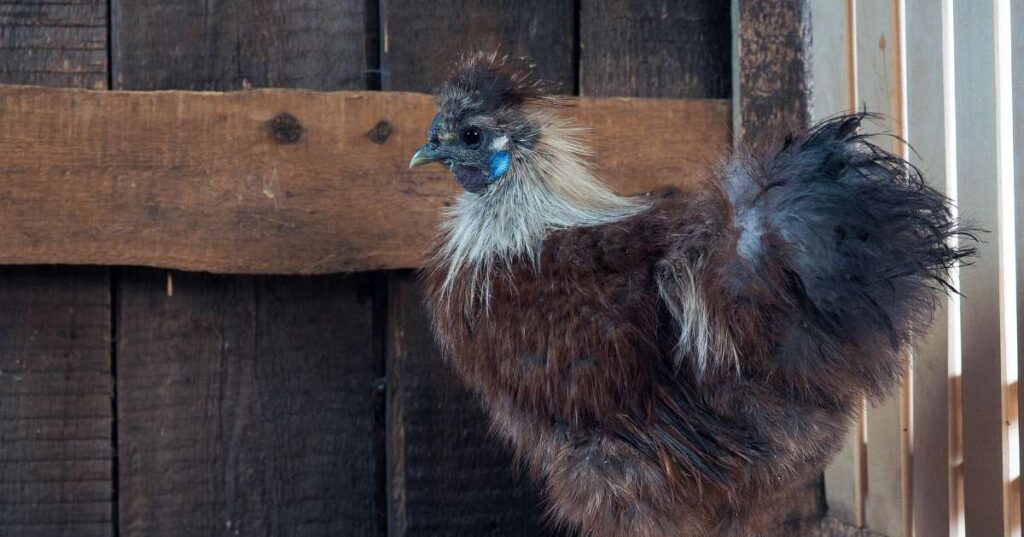For many years, Fluffy Chicken breeds have been our close companions. They have helped us in various ways, such as giving us tasty and fresh eggs, and keeping pests away from our backyard. One of the most delightful aspects of raising chickens is the wide variety of breeds available, each with its unique personality and appearance. Some species steal the show with their adorable and fluffy features, making them a hit, especially among children. These lovable feathered friends quickly become cherished family members, adding color and character to your backyard.
However, raising chickens is about more than just eggs and their cute looks. It provides an opportunity to connect with nature and learn valuable lessons in responsibility and compassion. Caring for living creatures brings its rewards and teaches us essential life skills.
This article will explore the reasons behind its growing popularity, share insights for successful chicken care, and introduce you to some of the most enchanting chicken breeds.
Contents
The Beauty and Delight of Fluffy Chicken Breeds
“Fluffy chicken breeds are captivating creatures that add beauty and delight to any flock or backyard. With their soft and voluminous plumage, these birds create a mesmerizing sight. Their feathers come in stunning colors, showcasing nature’s creativity. From vibrant blacks to radiant whites and ethereal blues, their plumage is truly a work of art.
However, it’s not just their appearance that makes them unique; fluffy chicken breeds also possess charming personalities. They are known for their gentle and docile nature, which makes them friendly and lovable companions. Whether pecking around the yard or cuddling up for attention, their quirky antics bring joy to those around them.
#1 Silkie Chickens
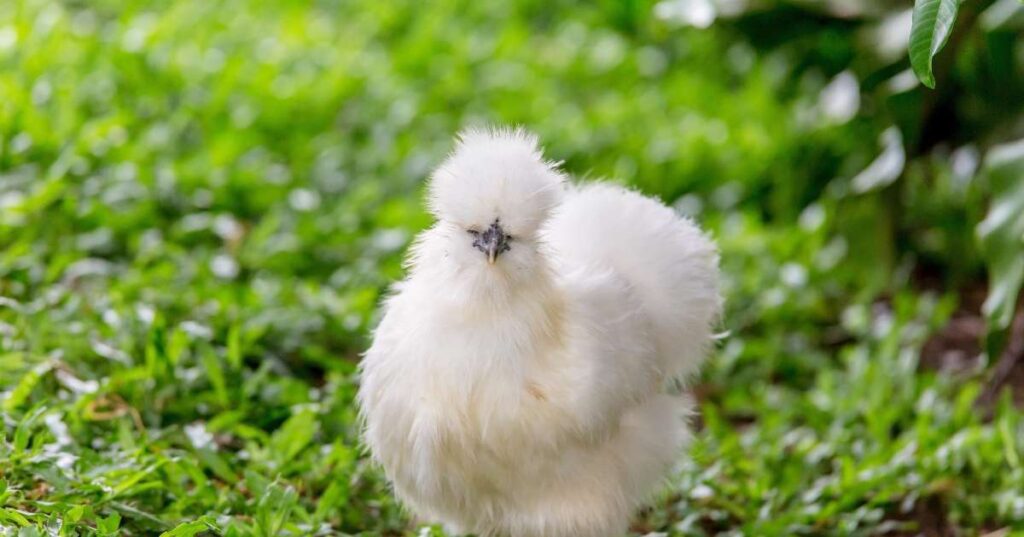
Silkie Chickens, originating from ancient China, have fascinated poultry enthusiasts for generations. These remarkable birds have found a special place in feathered companionship with their unique characteristics and irresistible charm.
Lifespan
Silkie Chickens typically have a lifespan of around 7 to 10 years. With proper care, some individuals have been known to live up to 12 years, extending their delightful companionship.
Egg Production
While Silkie Chickens may not be prolific egg layers, they compensate with their remarkable broodiness and maternal instincts. They focus more on nurturing their eggs than producing a constant stream. If you prioritize consistent egg production, consider other breeds.
Pros of Silkie Chickens
- Silkie Chickens have a unique and captivating look. Their feathers are soft and fluffy, which is different from what we usually consider beautiful in birds. They come in many pretty colors and can make any group of chickens look more elegant.
- These adorable animals are naturally calm and friendly, making them perfect companions for people of any age. They create a peaceful and friendly atmosphere in homes or poultry communities.
- Silkie Chickens are renowned for their dedication to incubating and caring for eggs. Their exceptional broodiness and maternal instincts result in a higher success rate in hatching and nurturing adorable chicks.
Cons of Silkie Chickens
- Due to their focus on broodiness, Silkie Chickens may not provide a constant supply of eggs. Other breeds may be more suitable for your needs if a regular and abundant egg yield is essential.
- Silkie Chickens have beautiful feathers but are more sensitive to extreme weather. Because their fluffy feathers don’t offer much protection, they need proper shelter and extra care when the weather gets tough.
- Silkie Chickens, just like any other living creature, can have health problems. Their fluffy feathers can attract bugs and cause breathing issues.
#2 Polish Chickens

Polish Chickens have a captivating history that traces back to Eastern Europe, where the Polish nobility once revered them. These magnificent birds have always stood out among their feathered peers with their regal bearing and striking plumage.
Lifespan
On average, these birds live between 5 to 8 years, gracing us with their presence for a significant period.
Egg Production
While not the most prolific layers, Polish Chickens make up for it with their unique charm. Annually, they typically produce around 150 to 200 eggs. Each delicate creation requires dedicated care and attention, a small gift from your feathery companion.
Pros of Polish Chickens
- Polish Chickens captivate with more than just their egg production; their beautiful appearance features magnificent feathers adorning their regal crowns.
- Introducing these birds to your poultry collection adds a touch of splendor, elevating the overall ambiance.
- Their serene and gentle nature fosters a peaceful atmosphere wherever they roam.
- Despite their relatively compact size, Polish Chickens thrive effortlessly in urban and rural settings.
Cons of Polish Chickens
- Polish Chickens, known for their majestic appearance, have a few essential factors to remember.
- Their magnificent crests can occasionally hinder their vision, resulting in moments of clumsiness.
- Their striking plumage requires regular upkeep to avoid tangling and getting dirty.
- Due to their delicate frames, they are more susceptible to harsh weather, requiring adequate shelter and protection.
#3 Frizzle Chickens
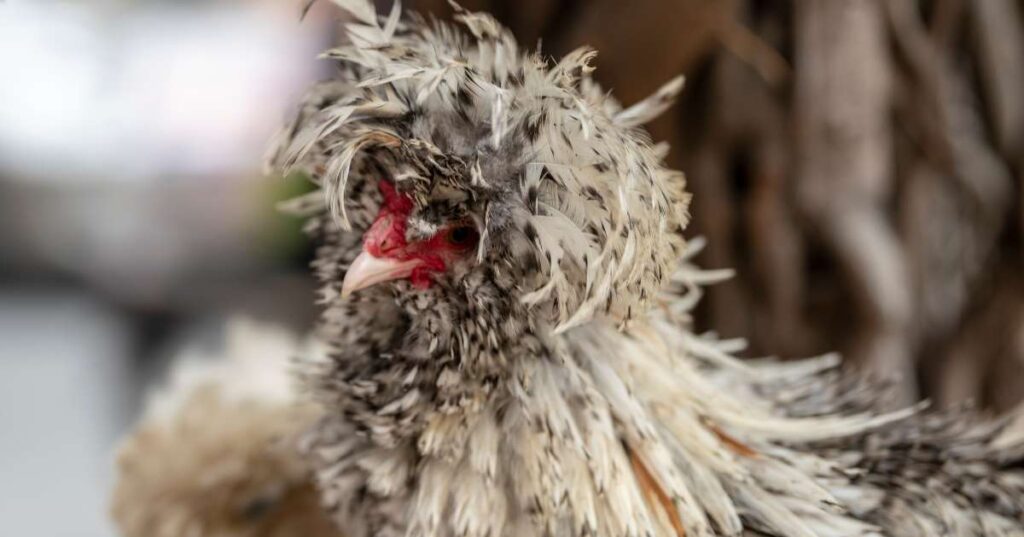
Frizzle Chickens originated in Asia, specifically the Indonesian islands. They were first bred in Java and had very distinct curly feathers. As time passed, they became increasingly popular and were brought to Europe and the Americas, capturing the interest of people who love raising chickens worldwide.
Lifespan
Frizzle Chickens can live for a decent amount, usually around 5 to 8 years. If properly cared for and given a good environment, these beautiful birds can make poultry enthusiasts happy for their entire lives. Having them in a group of chickens adds a unique charm and fascination that many people appreciate.
Egg Production
Even though Frizzle Chickens are not famous for laying many eggs, they have other good qualities. Typically, they lay about three to four medium-sized eggs every week, which have a nice cream color. Although they don’t lay as many eggs as other chickens, their eggs are unique because of their appearance and high quality.
Pros of Frizzle Chickens
- Frizzle Chickens are loved because they look fascinating, with unique feathers curling outwards.
- They are gentle and friendly, which makes them great pets for families and people who enjoy having feathered friends with personalities.
- Their medium-sized eggs add a special touch, making them perfect for gatherings or unique cooking adventures.
Cons of Frizzle Chickens
- Just like any particular type of chicken, Frizzle Chickens need special attention.
- Their soft feathers require extra care to keep them healthy because they can easily get damaged.
- Their feathers are structured in a unique way, which means they may be more sensitive to extreme weather.
#4 Orpington Chickens
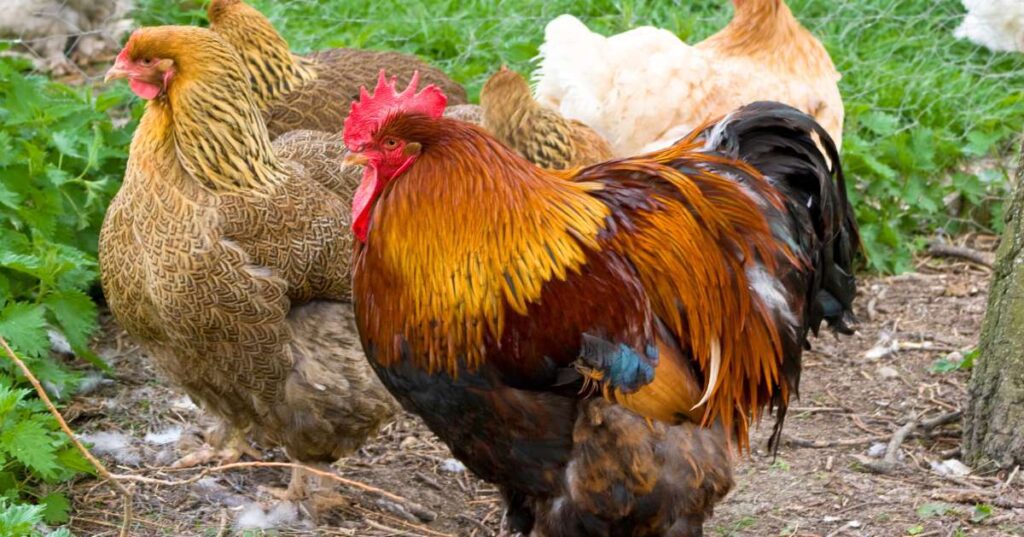
Orpington Chickens hail from England, mainly from Orpington in Kent. They were created by a man named William Cook during the late 1800s. Cook aimed to develop a breed that excelled in meat production and egg laying.
Lifespan
These chickens typically live for around 8 to 10 years, although with proper care, they can sometimes surpass a decade. Factors such as genetics, diet, and living environment influence their lifespan.
Egg Production
Orpington Chickens are moderately productive in terms of egg-laying. On average, hens of this breed produce approximately 200 to 280 brown eggs per year. The size of the eggs is generally large, and they are known for their delicious flavor.
Pros of Orpington Chickens
- Orpington Chickens are gentle and friendly, making them suitable for families, including children. They are easy to handle due to their docile demeanor and are less likely to display aggressive behavior.
- These chickens are well-suited for colder climates thanks to their fluffy feathers, which provide insulation and help keep them warm during chilly seasons.
- Orpington Chickens are highly regarded for their meat, known for being tender and flavorful. Their meat makes a delectable addition to the dining table.
Cons of Orpington Chickens
- Due to their larger size and heavy build, Orpington Chickens may be more prone to specific health problems, including joint issues and obesity.
- The feathering of Orpington Chickens requires regular upkeep to prevent matting and cleanliness problems.
- If you’re seeking high egg yields, it’s important to note that Orpington Chickens have a moderate egg production rate. They lay a sufficient number of eggs but fewer than some other breeds.
#5 Cochin Chickens
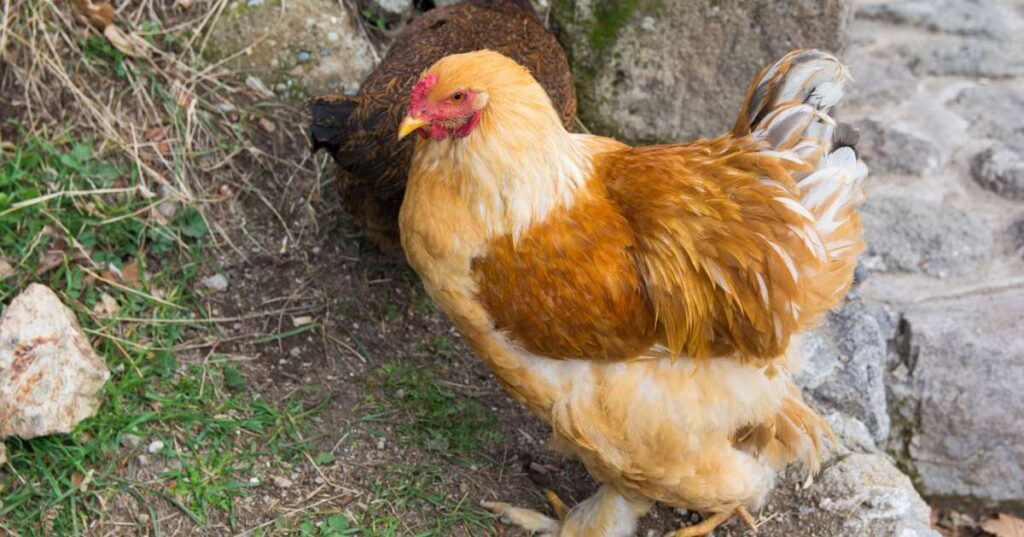
Cochin Chickens have an interesting background, originating from China’s Cochin province. These captivating birds made their way to Europe in the mid-19th century and gained popularity for their unique appearance and gentle demeanor.
Lifespan
Cochin Chickens have an excellent lifespan regarding how long they live. On average, they can live for 8 to 10 years, and with proper care, they can even exceed a decade, making them cherished members of your flock.
Egg Production
While Cochin Chickens may not be the most prolific layers, their other characteristics make up for it. They typically lay around 150 to 180 brown eggs per year. Although their egg production may not be as high as some other breeds, their eggs are giant and taste delightful.
Pros of Cochin Chickens
- Cochin Chickens are known for their eye-catching looks. With their fluffy feathers, feathered legs, and various color variations, they add elegance and charm to any flock or backyard.
- These birds have a calm and friendly nature, making them an excellent choice for families and beginners. They are easy to handle and care for due to their pleasant disposition.
- Cochin Chickens exhibit solid maternal instincts, excelling in nesting and raising chicks. This trait is beneficial for those interested in breeding or expanding their flock.
Cons of Cochin Chickens
- Cochin Chickens take longer to mature compared to other breeds.
- It may take 6 to 8 months to reach their full size and start laying eggs. Patience is required when raising Cochins.
- While Cochins have many positive qualities, their egg production is relatively lower. If you desire many eggs, other breeds may suit your needs.
#6 Brahma Chickens

Brahma Chickens have an interesting backstory. They were created in the United States during the mid-19th century by crossing giant fowl chickens from China. The goal was to develop a breed known for its size, durability, and gentle temperament.
Lifespan
Brahma Chickens have a decent lifespan. On average, they live for about 6 to 8 years. They can sometimes live even longer with proper care, becoming cherished members of your flock.
Egg Production
Brahma Chickens are intermediate layers, producing a reasonable number of eggs. Typically, they lay around 150 to 200 brown eggs per year. While their egg production may not be as high as some other breeds, the quality of their eggs, known for their rich flavor and good size, is highly regarded.
Pros of Brahma Chickens
- Brahma Chickens are known for their large size, making them visually striking in any flock. Their robust and sturdy build sets them apart and adds an element of grandeur to your backyard.
- These birds have a calm and friendly nature, making them an excellent choice for families and beginners. They are easy to handle and interact with due to their docile demeanor.
- Brahma Chickens are well-suited for colder climates. Their heavy feathering provides insulation, keeping them warm during chilly seasons and comfortable in more relaxed environments.
Cons of Brahma Chickens
- Brahma Chickens need more time to grow up than other kinds of chickens. It may take them around 6 to 8 months to grow fully and begin laying eggs. Being patient when raising Brahmas is essential, especially in the beginning.
- Given their larger size, Brahma Chickens need ample space to thrive. It’s essential to provide them with a suitable living environment with enough room to roam and be comfortable.
#7 Sultan Chickens

Sultan Chickens, with their majestic background from the Ottoman Empire, charm us with their breathtaking beauty. Sultans and nobles adored these regal birds for their elegance. These chickens carry a rich history and still captivate poultry lovers today. Having Sultan Chickens lets us actively embrace their royal heritage and witness their enchanting presence up close.
Lifespan
One notable aspect of Sultan Chickens is their impressive lifespan. They tend to live longer than other chicken breeds, around 5 to 8 years.
Egg Production
While Sultan Chickens may not lay as many eggs as some other breeds, the eggs they do produce are special. These tiny eggs come in various delicate colors, adding an air of uniqueness to your collection.
Pros of Sultan Chickens
- Their stunning appearance makes them stand out in any flock, capturing attention with their striking features.
- Their calm and gentle nature allows them to coexist peacefully with other breeds, promoting a harmonious environment.
- Sultan Chickens possess impressive showmanship qualities, making them famous for exhibitions and competitions.
Cons of Sultan Chickens
- Their elaborate plumage requires regular grooming and maintenance to keep it looking its best.
- Due to their delicate nature, they may need extra protection from harsh weather conditions.
- Their egg production is lower than breeds focused on high yields.
#8 Faverolle Chickens

Faverolle chickens have a captivating history, originating in France during the late 19th century. They were bred by crossing Houdans, Dorkings, and Asiatics, resulting in a unique breed known for its distinct features and gentle temperament.
Lifespan
These remarkable birds boast an impressive lifespan of 5 to 7 years, surpassing many other chicken breeds. With proper care, Faverolles can provide companionship and productivity for a significant period.
Egg Production
When it comes to laying eggs, Faverolles excel. They are diligent layers, consistently producing a generous supply of high-quality eggs. These eggs not only taste delicious but also have an appealing appearance.
Pros of Faverolle Chickens
- Their docile nature makes them easy to handle and a pleasure to have around.
- Their beautiful feather patterns and colors add a touch of visual appeal to any flock.
Cons of Faverolle Chickens
- Faverolles tend to be broody, meaning they may want to nest and hatch eggs rather than focusing solely on egg production.
- Their feathered feet require extra care and attention to maintain cleanliness and prevent potential health issues.
#9 Wyandotte Chickens
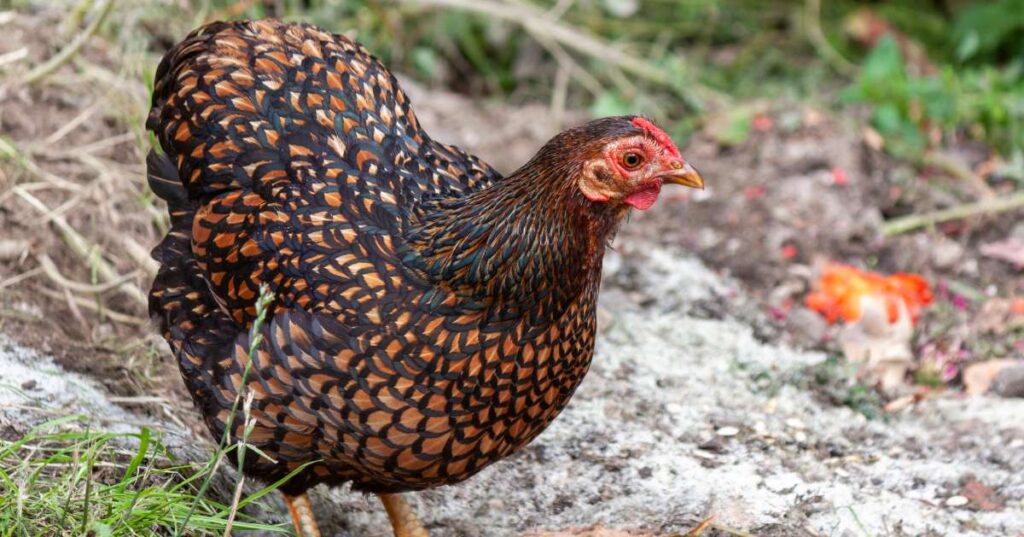
Wyandotte chickens combine beauty, utility, and resilience, making them a delightful addition to any poultry collection. Wyandotte chickens have a history that dates back to the late 1800s in the United States, particularly in New York. They were developed by crossbreeding various chicken breeds, such as Silver and Golden Laced. This intentional mixing led to the creation of the Wyandotte chicken breed, which is both attractive and valuable, and greatly admired by poultry enthusiasts worldwide.
Lifespan
Wyandotte chickens have a decent lifespan, living on average for 6 to 10 years. They are known for their vitality and can grace any poultry flock with their beauty and presence for a considerable period.
Egg Production
One of the remarkable qualities of Wyandotte chickens is their ability to lay many eggs. They are consistent producers, offering around 200 to 220 eggs per year. This makes them a reliable source of fresh, high-quality eggs for households and farmers.
Pros of Wyandotte Chickens
- Wyandotte Chickens are visually appealing, with intricate patterns and colors that add charm to any poultry collection.
- They are adaptable to different climates, thanks to their resilient nature.
- Their commendable egg-laying capabilities ensure a steady supply of fresh eggs, making them a popular choice for those seeking a reliable source of nourishment.
Cons of Wyandotte Chickens
- Due to their larger size than other chicken breeds, they require adequate space and resources to thrive.
- Their beautiful feathers need occasional upkeep to prevent tangling or matting.
- Their friendly and docile nature can sometimes make them vulnerable to bullying from more assertive flock members, necessitating careful monitoring and management within mixed chicken populations.
#10 Australorp Chickens
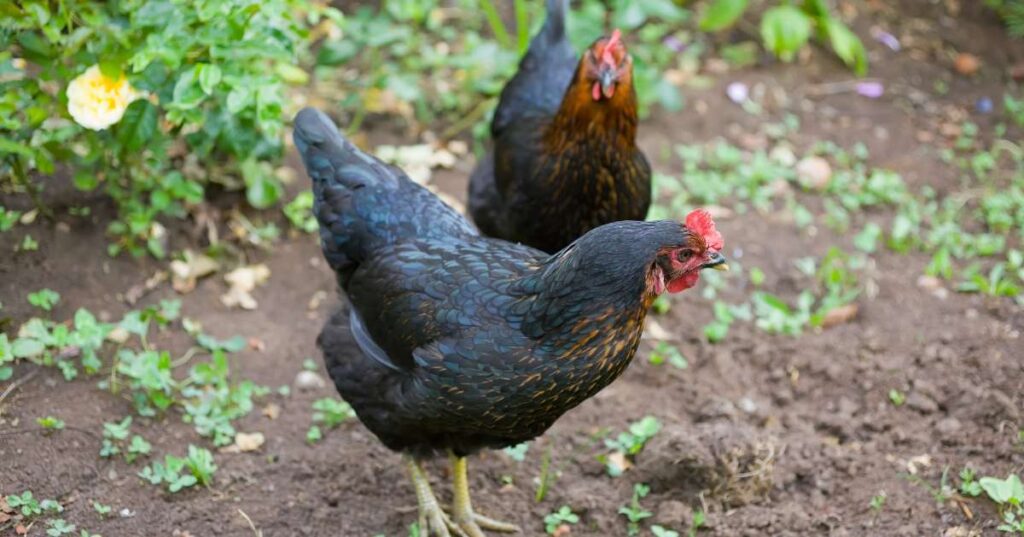
The Australorp chickens have their roots in Australia. They have a captivating history filled with adventure and evolution. Australorp chickens are fascinating and versatile creatures. They combine beauty, resilience, and high egg production, making them a valuable addition to any poultry venture.
Lifespan
These chickens mature quickly, reaching adulthood in 5 months, and live to be approximately 6-10 years of age.
This makes them popular among both new and experienced poultry enthusiasts.
Egg Production
When it comes to laying eggs, Australorps are exceptional. They have an impressive record, producing up to 300 brown eggs annually. This means a steady supply of fresh and nutritious eggs for your family or business.
Pros of Australorp Chickens
- Australorps are calm and gentle, making them great companions in rural and urban settings.
- Australorps add an elegant touch to any poultry collection with their glossy black feathers.
- These chickens are excellent foragers, which helps keep pests and weeds in check, contributing to a healthier environment.
Cons of Australorp Chickens
- Due to their size and curious nature, Australorps may test the strength of fences or enclosures. It’s essential to ensure secure boundaries to prevent any accidents.
- Australorps have hearty appetites, which can lead to increased feed costs. Monitoring their food intake is necessary to avoid excessive expenses.
Tips for Caring for Fluffy Chickens
Caring for fluffy chickens is a rewarding endeavor that requires dedication and attentiveness. Here are some essential tips for fluffy chickens:
Housing and Environment: Creating a comfortable and safe living space is crucial for your fluffy chickens. Build a spacious coop that allows them to move around freely and engage in natural behaviors. Make sure the coop is well-insulated and adequately ventilated. Provide nesting boxes, perches, and soft bedding for their comfort.
Balanced Nutrition: A balanced diet is essential for the health of your fluffy chickens. Choose a high-quality poultry feed that contains all the necessary nutrients. Additionally, offer fresh vegetables, fruits, and occasional protein treats to support their growth and immune system.
Hydration and Clean Water: Keeping your chickens hydrated is essential. Always provide them with clean and fresh water, changing it regularly to prevent contamination. Consider using a reliable waterer to ensure a steady supply of water.
Health Monitoring: Regularly check your fluffy chickens for signs of illness, parasites, or injuries. Observe their behavior, appetite, and appearance closely. If you notice anything unusual, consult a poultry veterinarian for advice.
Grooming and Feather Maintenance: Check your chickens’ feathers for mites, lice, or other parasites. Keep their feathers clean by occasionally giving them a gentle bath if needed.
Socialization and Enrichment: Chickens are social animals that enjoy interaction and mental stimulation. Provide them with compatible companions and enrich their environment with perches, toys, and objects to peck at. This will keep them entertained and prevent boredom.
Conclusion
Fluffy chicken breeds bring beauty, delight, and charm to any backyard or flock. Their captivating appearance, unique personalities, and gentle nature make them lovable companions for people of all ages. Raising these enchanting feathered friends adds color and character to your surroundings and provides an opportunity to connect with nature and learn valuable lessons in responsibility and compassion.
While some fluffy breeds may not be the most prolific egg layers, their other qualities, such as broodiness and maternal instincts, make up for it. Whether you’re drawn to the Silkie, Polish, Frizzle, Orpington, Cochin, Brahma, Sultan, Faverolle, Wyandotte, or Australorp, each breed offers unique traits and attributes that will be adored. So, embrace the beauty of these fluffy chicken breeds and let them bring joy and wonder to your life and backyard.

